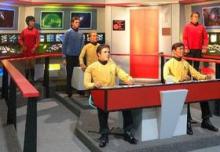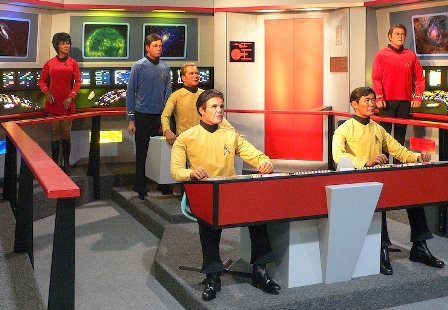User login
Attention Trekkies – the tricorder is here! Well, almost. The healthy possibility of this development has both doctors and Star Trek fans excited. (Admit it – there are more than a few of you who qualify as both.)
I’m talking about the all-in-one, supersmart device that doctors on the fictional U.S.S. Enterprise and subsequent starships would simply wave over a patient’s body to obtain an instant diagnosis. The tricorder is possible today, thanks to advances in the miniaturization and portability of standard medical testing platforms, portability of devices, self-testing by patients, and informatics.
The first real iteration of the device won’t be quite that simple, but "the tricorder is coming very soon," Dr. Franklin R. Cockerill III said in a plenary session at the annual Interscience Conference on Antimicrobial Agents and Chemotherapy (ICAAC).
In recognition that this is possible, the communications corporation Qualcomm is offering a $10 million prize in a Tricorder X-Prize Contest to the team that builds the best device that weighs less than 5 pounds, can be used by patients, and screens for melanoma and diagnoses anemia, urinary tract infection, diabetes, strep throat, sleep apnea, chronic obstructive pulmonary disease, metabolic abnormalities, hypo- or hyperthyroidism, and the absence of these diseases.
"You may be very skeptical about this, but it’s possible," said Dr. Cockerill, professor of microbiology and medicine and chair of the department of laboratory medicine and pathology at the Mayo Clinic, Rochester, Minn.
His team at the clinic has been working on tricorder concepts. Ever-smaller computer chips can analyze large amounts of data collected into a tricorder from biosensors and patient-collected specimens, transcript information by smartphones, and use very little energy in doing so.
Even tricorderlike polymerase chain reaction (PCR) testing is feasible, performed by patients using disposable PCR units, he said at the meeting, sponsored by the American Society for Microbiology. Theoretically, 30 cycles of PCR testing could be done in 30 seconds using an AA battery, lyophilized reagents, and self-collected specimens in a disposable device.
He and his associates showed in a recent study that nasal swabs collected by patients were as good as swabbing by health care workers for PCR to detect influenza A and B virus (Mayo Clin. Proc. 2012:87:548-54).
For more than a decade, patients in the Mayo health plan with suspected group A streptococcus infection have complained of the hassle of getting into an office for a health care provider to collect a swab specimen, after which PCR results are available via an 800 phone number within 6-8 hours and they can pick up a medication, if needed, at a prearranged pharmacy. Patient self-sampling is the next step.
"This sort of streamlining of delivery of patient care is where we’re going to go in iterative phases to eventually a tricorder," he said. "I think we’ll see that many physicians are going to be managers over testing, some of which is done by the patients. You will move that patient forward in a more efficient way toward intervention if they require it."
Already, physicians are being "pummeled" with more and more data points, laboratory information, and vital signs without the ability to react in dynamic ways, he added. How to manage all this? Dr. Cockerill predicted that tricorderlike tools will enable real-time integrative interpretation of data at the bedside.
He described a theoretical scenario: Data from automated surveillance of a patient in the ICU will be interpreted in real time. Tricorderlike tools might report that at 8:32 a.m. the patient has a 77% chance of having sepsis, a 79% chance of pneumonia, and only a 13% chance of pulmonary embolus. The device then suggests that the probabilities be better defined by assessing for small molecules 257, 396, and 422 (which are being studied by mass spectrometry as diagnostic adjuncts in trials now, he noted). The presence of small molecule 257 might prompt the device to revise the risk of sepsis to 97%.
For the moment, it’s a scenario he simply made up, and it may seem "heretical" to some of his infectious disease colleagues, but "I think this is what’s coming," Dr. Cockerill said.
Medicine isn’t the only field getting in on the tricorder game. After all, in Star Trek the tricorder was used for much more. A nonmedical tricorder prototype collects and analyzes atmospheric and spatial data, Reuters reports.
Although in the early phases, tricorders are coming. Once they’re everywhere, can Star Trek’s transporters be far behind? Beam me up, Scottie!
Dr. Cockerill reported relationships with nanoMR and Roche, whose products were not discussed in his talk.
–Sherry Boschert
Attention Trekkies – the tricorder is here! Well, almost. The healthy possibility of this development has both doctors and Star Trek fans excited. (Admit it – there are more than a few of you who qualify as both.)
I’m talking about the all-in-one, supersmart device that doctors on the fictional U.S.S. Enterprise and subsequent starships would simply wave over a patient’s body to obtain an instant diagnosis. The tricorder is possible today, thanks to advances in the miniaturization and portability of standard medical testing platforms, portability of devices, self-testing by patients, and informatics.
The first real iteration of the device won’t be quite that simple, but "the tricorder is coming very soon," Dr. Franklin R. Cockerill III said in a plenary session at the annual Interscience Conference on Antimicrobial Agents and Chemotherapy (ICAAC).
In recognition that this is possible, the communications corporation Qualcomm is offering a $10 million prize in a Tricorder X-Prize Contest to the team that builds the best device that weighs less than 5 pounds, can be used by patients, and screens for melanoma and diagnoses anemia, urinary tract infection, diabetes, strep throat, sleep apnea, chronic obstructive pulmonary disease, metabolic abnormalities, hypo- or hyperthyroidism, and the absence of these diseases.
"You may be very skeptical about this, but it’s possible," said Dr. Cockerill, professor of microbiology and medicine and chair of the department of laboratory medicine and pathology at the Mayo Clinic, Rochester, Minn.
His team at the clinic has been working on tricorder concepts. Ever-smaller computer chips can analyze large amounts of data collected into a tricorder from biosensors and patient-collected specimens, transcript information by smartphones, and use very little energy in doing so.
Even tricorderlike polymerase chain reaction (PCR) testing is feasible, performed by patients using disposable PCR units, he said at the meeting, sponsored by the American Society for Microbiology. Theoretically, 30 cycles of PCR testing could be done in 30 seconds using an AA battery, lyophilized reagents, and self-collected specimens in a disposable device.
He and his associates showed in a recent study that nasal swabs collected by patients were as good as swabbing by health care workers for PCR to detect influenza A and B virus (Mayo Clin. Proc. 2012:87:548-54).
For more than a decade, patients in the Mayo health plan with suspected group A streptococcus infection have complained of the hassle of getting into an office for a health care provider to collect a swab specimen, after which PCR results are available via an 800 phone number within 6-8 hours and they can pick up a medication, if needed, at a prearranged pharmacy. Patient self-sampling is the next step.
"This sort of streamlining of delivery of patient care is where we’re going to go in iterative phases to eventually a tricorder," he said. "I think we’ll see that many physicians are going to be managers over testing, some of which is done by the patients. You will move that patient forward in a more efficient way toward intervention if they require it."
Already, physicians are being "pummeled" with more and more data points, laboratory information, and vital signs without the ability to react in dynamic ways, he added. How to manage all this? Dr. Cockerill predicted that tricorderlike tools will enable real-time integrative interpretation of data at the bedside.
He described a theoretical scenario: Data from automated surveillance of a patient in the ICU will be interpreted in real time. Tricorderlike tools might report that at 8:32 a.m. the patient has a 77% chance of having sepsis, a 79% chance of pneumonia, and only a 13% chance of pulmonary embolus. The device then suggests that the probabilities be better defined by assessing for small molecules 257, 396, and 422 (which are being studied by mass spectrometry as diagnostic adjuncts in trials now, he noted). The presence of small molecule 257 might prompt the device to revise the risk of sepsis to 97%.
For the moment, it’s a scenario he simply made up, and it may seem "heretical" to some of his infectious disease colleagues, but "I think this is what’s coming," Dr. Cockerill said.
Medicine isn’t the only field getting in on the tricorder game. After all, in Star Trek the tricorder was used for much more. A nonmedical tricorder prototype collects and analyzes atmospheric and spatial data, Reuters reports.
Although in the early phases, tricorders are coming. Once they’re everywhere, can Star Trek’s transporters be far behind? Beam me up, Scottie!
Dr. Cockerill reported relationships with nanoMR and Roche, whose products were not discussed in his talk.
–Sherry Boschert
Attention Trekkies – the tricorder is here! Well, almost. The healthy possibility of this development has both doctors and Star Trek fans excited. (Admit it – there are more than a few of you who qualify as both.)
I’m talking about the all-in-one, supersmart device that doctors on the fictional U.S.S. Enterprise and subsequent starships would simply wave over a patient’s body to obtain an instant diagnosis. The tricorder is possible today, thanks to advances in the miniaturization and portability of standard medical testing platforms, portability of devices, self-testing by patients, and informatics.
The first real iteration of the device won’t be quite that simple, but "the tricorder is coming very soon," Dr. Franklin R. Cockerill III said in a plenary session at the annual Interscience Conference on Antimicrobial Agents and Chemotherapy (ICAAC).
In recognition that this is possible, the communications corporation Qualcomm is offering a $10 million prize in a Tricorder X-Prize Contest to the team that builds the best device that weighs less than 5 pounds, can be used by patients, and screens for melanoma and diagnoses anemia, urinary tract infection, diabetes, strep throat, sleep apnea, chronic obstructive pulmonary disease, metabolic abnormalities, hypo- or hyperthyroidism, and the absence of these diseases.
"You may be very skeptical about this, but it’s possible," said Dr. Cockerill, professor of microbiology and medicine and chair of the department of laboratory medicine and pathology at the Mayo Clinic, Rochester, Minn.
His team at the clinic has been working on tricorder concepts. Ever-smaller computer chips can analyze large amounts of data collected into a tricorder from biosensors and patient-collected specimens, transcript information by smartphones, and use very little energy in doing so.
Even tricorderlike polymerase chain reaction (PCR) testing is feasible, performed by patients using disposable PCR units, he said at the meeting, sponsored by the American Society for Microbiology. Theoretically, 30 cycles of PCR testing could be done in 30 seconds using an AA battery, lyophilized reagents, and self-collected specimens in a disposable device.
He and his associates showed in a recent study that nasal swabs collected by patients were as good as swabbing by health care workers for PCR to detect influenza A and B virus (Mayo Clin. Proc. 2012:87:548-54).
For more than a decade, patients in the Mayo health plan with suspected group A streptococcus infection have complained of the hassle of getting into an office for a health care provider to collect a swab specimen, after which PCR results are available via an 800 phone number within 6-8 hours and they can pick up a medication, if needed, at a prearranged pharmacy. Patient self-sampling is the next step.
"This sort of streamlining of delivery of patient care is where we’re going to go in iterative phases to eventually a tricorder," he said. "I think we’ll see that many physicians are going to be managers over testing, some of which is done by the patients. You will move that patient forward in a more efficient way toward intervention if they require it."
Already, physicians are being "pummeled" with more and more data points, laboratory information, and vital signs without the ability to react in dynamic ways, he added. How to manage all this? Dr. Cockerill predicted that tricorderlike tools will enable real-time integrative interpretation of data at the bedside.
He described a theoretical scenario: Data from automated surveillance of a patient in the ICU will be interpreted in real time. Tricorderlike tools might report that at 8:32 a.m. the patient has a 77% chance of having sepsis, a 79% chance of pneumonia, and only a 13% chance of pulmonary embolus. The device then suggests that the probabilities be better defined by assessing for small molecules 257, 396, and 422 (which are being studied by mass spectrometry as diagnostic adjuncts in trials now, he noted). The presence of small molecule 257 might prompt the device to revise the risk of sepsis to 97%.
For the moment, it’s a scenario he simply made up, and it may seem "heretical" to some of his infectious disease colleagues, but "I think this is what’s coming," Dr. Cockerill said.
Medicine isn’t the only field getting in on the tricorder game. After all, in Star Trek the tricorder was used for much more. A nonmedical tricorder prototype collects and analyzes atmospheric and spatial data, Reuters reports.
Although in the early phases, tricorders are coming. Once they’re everywhere, can Star Trek’s transporters be far behind? Beam me up, Scottie!
Dr. Cockerill reported relationships with nanoMR and Roche, whose products were not discussed in his talk.
–Sherry Boschert


